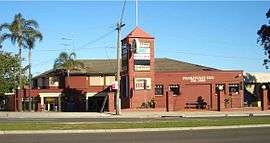Peakhurst, New South Wales
| Peakhurst Sydney, New South Wales | |||||||||||||
|---|---|---|---|---|---|---|---|---|---|---|---|---|---|
 Peakhurst Inn, Forest Road | |||||||||||||
| Population | 9,180 (2006 census)[1] | ||||||||||||
| Established | 1840 | ||||||||||||
| Postcode(s) | 2210 | ||||||||||||
| Location | 21 km (13 mi) south of Sydney CBD | ||||||||||||
| LGA(s) | Georges River Council | ||||||||||||
| State electorate(s) | Oatley | ||||||||||||
| Federal Division(s) | Banks | ||||||||||||
| |||||||||||||
Peakhurst is a suburb in Southern Sydney, or the St George Area, in the state of New South Wales, Australia 21 kilometres south of the Sydney central business district. Peakhurst is in the local government area of the Georges River Council.
Peakhurst has a western border on Salt Pan Creek, on the Georges River. Peakhurst Heights is a separate suburb to the south, which is bordered by Boggywell Creek and Lime Kiln Bay, on the Georges River. Peakhurst Heights is sometimes still considered to be part of 'Peakhurst' by some residents of the area.
History
Peakhurst was named after landholder John Robert Peake, who bought 10 acres of land near the junction of the present Forest Road and Henry Lawson Drive in 1838. He gave a block of land on which the Wesleyan Church was built in 1855.[2]
The area was originally part of an 1808 land grant to Captain John Townson.[2] John Robert Peake bought his land from William Hebblewhite in 1838. School Inspector Huffer suggested that Peake's name be used to name the suburb when the public school was founded in 1871. The post office opened in 1885.[2]
The first industry in the area was timber-cutting, due to the surrounding natural forests being thick with a variety of woods, especially turpentine. The timber was carted to Sydney by bullock teams. As the land was cleared, orchardists followed the timber-cutters.[2]
Commercial area
Peakhurst's commercial centres are predominantly located along Forest Road and Boundary Road. Various retail shops, restaurants and cafes are located near the Peakhurst Inn Hotel on Forest Road. The hotel contains a pub and drive-through bottle shop. Peakhurst also contains a sizeable industrial area mainly on and around Boundary Road.
Transport
The main roads are Forest Road, Henry Lawson Drive, Stoney Creek Road, Boundary Road, Bonds Road, Broad Arrow Road, Isaac Street, Baumans Road. Forest Road, which links to Henry Lawson Drive at Peakhurst, is the busiest carriageway that extends through numerous other suburbs in Sydney.
Buses operate through Peakhurst.
Schools
There are four public schools: Georges River College Peakhurst Campus, Peakhurst Public School, Peakhurst South Public School,[3] Peakhurst West Public School.
Churches
Church@thepeak Anglican Church, Our Lady of Fatima Catholic Church, St Abraam and St Mikhail Al-Behairy Coptic Orthodox Church, Peakhurst Uniting Church, Spanish Evangelical Jerusalem Baptist Church, Samoan Assembly of God Church.
Sport and recreation
Popular recreational venues include Grandviews Bowling Club (lawn bowls), tennis courts, Peakhurst Park and the numerous sporting fields located at Gannon's Park. The soccer clubs here are Peakhurst United and Forest Rangers.
Population
Demographics
According to the 2006 Australian Bureau of Statistics Census of Population, there were 9,113 people usually resident in Peakhurst. 23.4% stated they were born overseas with the top countries of birth being China 2.9%, United Kingdom 2.7% and Republic of Macedonia 1.4%. English was stated as the only language spoken at home by 7% (surely not correct) of residents and the most common other languages spoken were Arabic 4.9%, Greek 4.6% and Cantonese 3.6%. The most common responses for religious affiliation were Catholic 28.1%, Anglican 21.6% and Orthodox 10.1%.[1]
Notable Residents
- Myles Joseph Dunphy (1891-1985) - architect and conservationist.[4]
- Elizabeth (Betsy) Matthias (1882-1963) - socialist and charity-worker.[5]
- Richard Farleigh (1960s-1980s), now residing in London, a successful private investor, former hedge fund manager, international chess player representing Bermuda and Monaco, and "Dragon" on the BBC Two reality television program Dragons' Den.
Politics
The City of Hurstville local government area which administers Peakhurst, consists of 12 councillors elected every four years. Peakhurst falls into two Wards of the city: Peakhurst Ward and Penshurst Ward. A further five suburbs are contained wholly or partly in the Peakhurst Ward: Riverwood, Mortdale, Oatley, Lugarno and Peakhurst Heights.
Environment
An audit of the environmental impact of the industrial area was commenced in September 2002.[6] Bushcare volunteers help preserve remnant pockets of native forestation. A very small number of fresh water watercourses exist in the suburb, mostly draining into Salt Pan Creek. A portion of the Peakhurst tree population was included in the 1990 National Trust Lugarno Tree Study.[7]
References
- 1 2 "Demographic and spatial analysts". .id the population experts.
- 1 2 3 4 The Book of Sydney Suburbs, Frances Pollon, Angus & Robertson Publishers, 1990, p.202, Published in Australia ISBN 0-207-14495-8
- ↑ http://www.peakhursts-p.schools.nsw.edu.au/
- ↑ Gowers, Richard. "Dunphy, Myles Joseph (1891–1985)". Australian Dictionary of Biography. Australian National University. Retrieved 12 July 2013.
- ↑ Burgmann, Verity. "Matthias, Elizabeth (Betsy) (1882–1963)". Australian Dictionary of Biography. Australian National University. Retrieved 12 July 2013.
- ↑ http://www.hurstville.nsw.gov.au/PageZone_Environment.asp?z=8&c=263&p=631
- ↑ http://www.nsw.nationaltrust.org.au/lts.html National Trust Lugarno Tree Study
External links
| Wikimedia Commons has media related to Peakhurst, New South Wales. |
- Hurstville City Council
- Australian Bureau of Statistics 2001 Census Data for Peakhurst
- Georges River College (Peakhurst Campus)
Coordinates: 33°57′55″S 151°03′01″E / 33.9654°S 151.0502°E